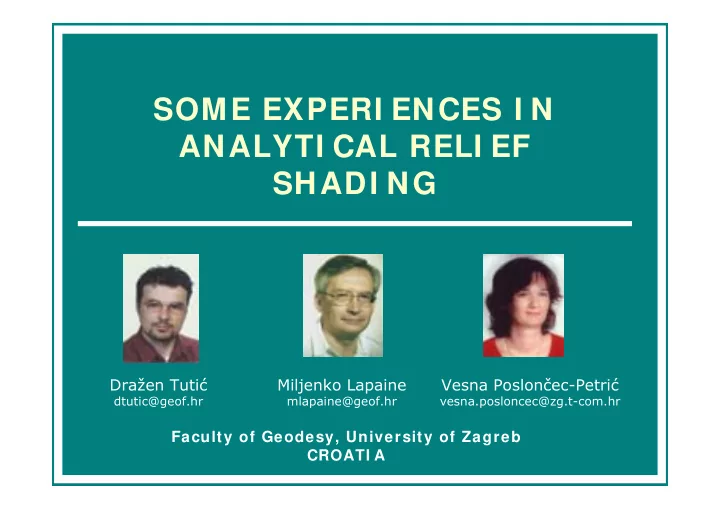

SOME EXPERI ENCES I N ANALYTI CAL RELI EF SHADI NG Dražen Tuti ć Miljenko Lapaine Vesna Poslon č ec-Petri ć dtutic@geof.hr mlapaine@geof.hr vesna.posloncec@zg.t-com.hr Faculty of Geodesy, University of Zagreb CROATI A
INTRODUCTION • Croatia has a number of mountains • Shaded reliefs in Croatia were done manually until recent days • Today, cartography in Croatia is in expansion – new series of the official topographic maps – national strategy towards tourism has encouraged publishers to provide all kinds of map products • Increasing need for relief shades
CROATIAN RELIEF (SRTM data) • Geomorphology of Croatian mountains: – 95 % sediment – 2-4 % metamorphic – 1 % vulcanic • Karst (krš) with it’s irregular shape is difficult to present with shades
MEDVEDNICA MOUNTAIN • Peek – 1035 m – 10 km from Zagreb’s main square • The most visited mountain in Croatia • The largest number of cartographic representations among Croatian mountains • DEM of Medvednica derived from contours from the topographic map at the scale of 1:25 000 will be used for examples
Perspective view of DEM The main ridgeline is in SW-NE direction with spurs perpendicular to this direction
Top of Medvednica (Lovri ć , 1993) N Average direction of light Shades are drawn manually. Adaptive direction of light
Panoramic view N Direction of light Artistic hand drawing
Bicycle map of Medvednica N Direction of light Analytical shading of digital relief model.
Photograph of the relief model (source unknown) Direction of light N
Hand drawn shades, by Ante Č ala N Direction of light
MOTIVATION • Absence of people specialized for manual relief shading • Shades prepared for one map usually cannot be reused for other maps • Investigate analytical relief shading and modify it to better serve the purpose for topographic and thematic maps
METHODOLOGY • Brassel’s work “Ein Modell zur automatischen Schräglichtschattierung”, 1974. • Modification of the azimuth, height and length of the vector of light • The goal: Weight of shades on the map: as small as possible while preserving the best perception of the relief
Weight of shades - raster matrix of shaded relief with values [0,255] calculated weight by this equation have relative meaning and does not represent final weight on printed map.
Weight calculated by equation 100% 0% 50%
DIFFUSE SHADING - normal vector of relief surface - vector of light Cosine of the angle between vectors and . , , v r Linear transformation from [min(D ij ),max(D ij )] to [0,255] ij
Vector of light triple x ij , y ij , z ij defining the radius vector height above horizon , azimuth , length
Diffuse shading A=135° H=45° I=1 N Direction of light Weight: 27%
Modification of azimuth Calculate the aspect a ij A = with starting direction (135°) A ij const . Transformation to the first quadrant: ( ) ( ) = a arcsin sin a ij ij Final azimuth of the light: = ± A A a ij const . ij
First step: aspect map with 135° as starting 180° direction 270° a ij 0° 180° 90° 0° 360°
0° Azimuth of the light = ± A A a ij const . ij 45° 45° 135° 135°
Modificaton of azimuth = ± A A a ij const . ij N Direction of light Weight: 28%
Comparison
Modification of height Calculate the slope of relief S ij Let the height be perpendicular to the slope: = 90 ° − H S ij ij
Height Slope 90° 90° 0° 0°
Modification of azimuth and height N Direction of light Height of light Weight: 14%
Modification of the length of vector ( ( ) ) = min 1 I R - length of the light vector for minimum elevation mn ( ( ) ) = max I R k - length of the light vector for maximun elevation mn Linear relationship between the length and elevation − ( ) 1 ( ) k 1 = − + , min I R R ( ) ( ) − ij ij mn max R min R mn mn Transformation to the grayscale If > R 255 ( ) ( ) ij 255 = − R D min D ( ) then − ij ij mn D min D = R 255 flat mn ij
All three modifications N Direction of light Height of light Length of vector Weight: 9%
CONCLUSION • Light vector as function of relief model can give different results • Presented modifications are simple and easy to interpret, and applicable to any relief model • Modificated results can be used for easier creation of final shades
Overlay of the shades on the map Standard diffuse shading Modification of the azimuth and height of the light (our approach)
Thank you!
Recommend
More recommend